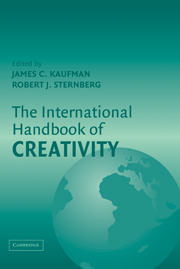Book contents
- Frontmatter
- Contents
- Acknowledgments
- List of Contributors
- 1 Introduction
- 2 Creativity Research in English-Speaking Countries
- 3 Creativity in Latin America
- 4 History of Creativity in Spain
- 5 Past, Present, and Future Perspectives on Creativity in France and French-Speaking Switzerland
- 6 Creativity in Italy
- 7 Creativity Research in German-Speaking Countries
- 8 Creativity Under the Northern Lights
- 9 Creativity in Soviet–Russian Psychology
- 10 Creativity Studies in Poland
- 11 Research on Creativity in Israel
- 12 Creativity in Turkey and Turkish-Speaking Countries
- 13 Development of Creativity Research in Chinese Societies
- 14 Creativity – A Sudden Rising Star in Korea
- 15 Culture and Facets of Creativity
- 16 African Perspectives on Creativity
- 17 Creativity Around the World in 80 Ways … but with One Destination
- Author Index
- Subject Index
- References
5 - Past, Present, and Future Perspectives on Creativity in France and French-Speaking Switzerland
Published online by Cambridge University Press: 05 June 2012
- Frontmatter
- Contents
- Acknowledgments
- List of Contributors
- 1 Introduction
- 2 Creativity Research in English-Speaking Countries
- 3 Creativity in Latin America
- 4 History of Creativity in Spain
- 5 Past, Present, and Future Perspectives on Creativity in France and French-Speaking Switzerland
- 6 Creativity in Italy
- 7 Creativity Research in German-Speaking Countries
- 8 Creativity Under the Northern Lights
- 9 Creativity in Soviet–Russian Psychology
- 10 Creativity Studies in Poland
- 11 Research on Creativity in Israel
- 12 Creativity in Turkey and Turkish-Speaking Countries
- 13 Development of Creativity Research in Chinese Societies
- 14 Creativity – A Sudden Rising Star in Korea
- 15 Culture and Facets of Creativity
- 16 African Perspectives on Creativity
- 17 Creativity Around the World in 80 Ways … but with One Destination
- Author Index
- Subject Index
- References
Summary
A summary of past and present research on creativity in France and Romande (French-speaking) Switzerland is proposed in this chapter. This task is difficult, however, because of the cultural diversity of France and Romande Switzerland. Historically, this region has long been a European crossroad for ideas and scientific knowledge. In the field of psychology, only a quick glance at its development reveals the depth and breadth of other cultures' influence, such as the nineteenth-century British empiricist and German experimental approaches, as well as positions of major psychologists such as Freud or James on the nature of the mind. We thus seek to isolate the specific contributions of researchers in France and Romande Switzerland in the understanding of creativity.
We primarily organize our review in a chronological fashion. In the first part, we discuss the writings of early thinkers and researchers, followed by theories exposed at the turn of the nineteenth-century, together with an examination of early empirical contributions. Then, between the two world wars, it seems that studying creativity became less of an issue for psychologists in France and Romande Switzerland, as the field concentrated on more graspable constructs. In the meantime, however, local experiments in the field of education led to the development of various tools and teaching methods that promoted creativity in children. After the Second World War, interest in creativity gained some momentum in France and Romande Switzerland as in many other geographical areas.
- Type
- Chapter
- Information
- The International Handbook of Creativity , pp. 96 - 123Publisher: Cambridge University PressPrint publication year: 2006
References
- 4
- Cited by



